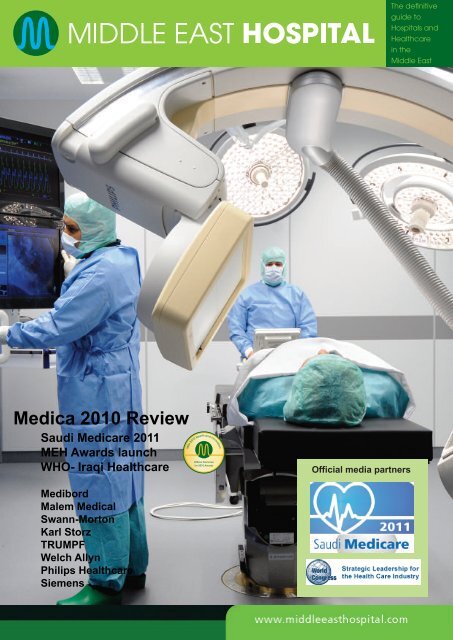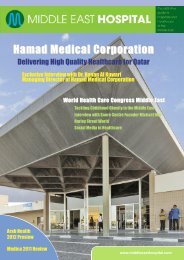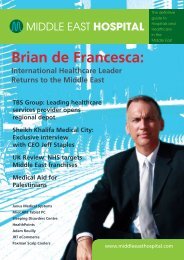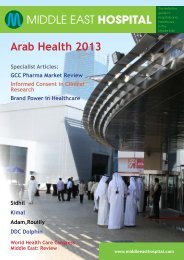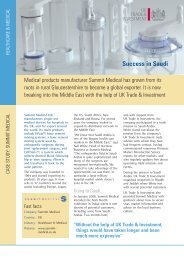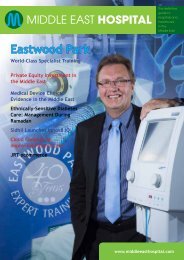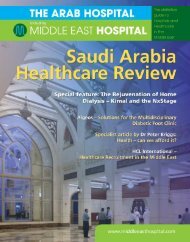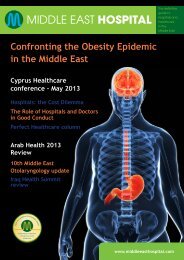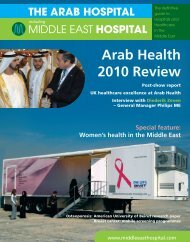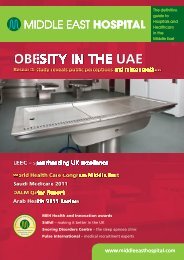MEH Dec10 - Middle East Hospital Magazine
MEH Dec10 - Middle East Hospital Magazine
MEH Dec10 - Middle East Hospital Magazine
You also want an ePaper? Increase the reach of your titles
YUMPU automatically turns print PDFs into web optimized ePapers that Google loves.
Medica 2010 ReviewSaudi Medicare 2011<strong>MEH</strong> Awards launchWHO- Iraqi Healthcare<strong>MEH</strong> 2010 Health and InnovationOfficial Nomineefor 2010 AwardsOfficial media partnersMedibordMalem MedicalSwann-MortonKarl StorzTRUMPFWelch AllynPhilips HealthcareSiemens
Editor’s IntroductionIn this issue we review Medica 2010, the world’slargest madical trade fair, which took place inDusseldorf, Germany, from 17-20 November.With 4400 ehibitors from 64 countries, and137,000 visitors, this is the keynote event of theyear for the medical technology industry.We look at some of the industry’s leadingcompanies exhibiting at the event, and theexciting and innovative products being launchedand showcased.Next month’s <strong>MEH</strong> will review the World HealthCare Congress <strong>Middle</strong> <strong>East</strong> held in Abu Dhabifrom 5-7 December and preview the Arab Healthtrade fair being held in Dubai from 24-27 January2011. We also profile some of the region’s besthospitals, with a special feature on the healthcarechallenges being created by the diabetesepidemic that is sweeping the Gulf region.December 2010 contents4-7 Medica 2010 Review8-9 TRUMPF- reliability, innovation,efficiency10-13 Saudi Medicare 201114-15 Welch Allyn- digital healthcaresolutions16-17 Karl Storz- OR excellence18-19 Philips- new alliance to combatCOPD20-21 Siemens- cancer screening inSaudi Arabia22-23 WHO healthcare report on IraqGuy Rowland, EditorEditor: Guy RowlandPublisher: Mike TanousisAssociate Publisher: Chris Silk<strong>MEH</strong> Publishing LimitedCompany Number 7059215151 Church RdShoeburynessEssex SS3 9EZUnited KingdomTel: 0044 1702 296776Mobile: 0044 0776 1202468Skype -mike.tanousis1<strong>MEH</strong> French officeGuy RowlandTel : 0033 952160441guyrowland@middleeasthospital.com<strong>MEH</strong> agent for EgyptDr.Amr SalahMillennium InternationalGroup(Managing Director)amr.salah@migaegypt.comTel: +2 0222736354Fax: +2 022747691Mobile: +2 0122227209Local contact for the U.A.E.Syed Abulhasan RizviTel +971509973956sarizvi@gmail.comTo discuss the submission ofan article for <strong>Middle</strong> <strong>East</strong> <strong>Hospital</strong>magazine please emaileditorial@middleeasthospital.comDecember 2010 | 3
<strong>Middle</strong> <strong>East</strong> <strong>Hospital</strong>MEDICA 2010 ReviewThe manufacturers of medicaltechnology and medical productshave weathered the phase ofeconomic and financial crisis well,now noticing a strong tailwind fortheir businesses and proving adriver for growth with theirinnovations. This is the coremessage to be taken away from thefour days at the world’s largestmedical fair MEDICA 2010Conducting a tour around theexhibition on 17 November GermanChancellor Angela Merkel andFederal Health Minister PhilippRösler were also able to convincethemselves of the performance ofthe medical technology industry."MEDICA is an impressive shopwindow on the health industry.However, our leading role in themedical business is not knowneverywhere. For this reason it isimportant for this sector to featurecentrestage," explained ChancellorMerkel in her speech.Alongside this high-ranking visitfrom members of the politicalsphere visitor numbers alsoconfirmed the highlighted globalstatus of MEDICA andCOMPAMED as leading trade fairsin their sectors. Of the 137,200visitors – matching the very goodlevel also achieved last year – 72%were decisively or significantlyinvolved in decision-making and afurther 10% had a consultativedecision-making role.For Joachim Schäfer, ManagingDirector at Messe Düsseldorf, thesetop ratings are a logicalconsequence of marketdevelopments: “The number ofclinic organising bodies is falling.This concentration of demandmeans the market is becomingdominated by ever-larger providerswith centrally organised purchasingdepartments. Which makes thosetravelling to Düsseldorf especiallyhigh-calibre decision-makers.”December 2010 | 4
<strong>Middle</strong> <strong>East</strong> <strong>Hospital</strong>MEDICA 2010 ReviewAbout half the visitors came fromabroad from a total of over 100nations.The medical experts fromthroughout the world were offered awealth of innovations for the entirepatient “workflow” in both in andoutpatient care by a recordattendance of 4,400 MEDICAexhibitors from 64 nations.Once again proving a significantsuccess factor at MEDICA was theevent’s focus on meeting theincreasing demands of the medicalcommunity for interdisciplinarycooperation with a comprehensiverange of topics including themeparks and forums (e.g. MEDICAMEDIA, MEDICA PHYSIO) as wellas the congress. “An example herewere the well attendedinterdisciplinary congress seminarson such topics as the care ofpatients with several parallelconditions or complex symptomslike cancer, rheumatism orallergies,” explained Dr. JuliaRautenstrauch, Secretary Generalof the German Society forInterdisciplinary Medicine.In terms of the innovationspresented by exhibitors “processoptimisation” was clearly the mostfrequently heard buzzword in thehalls of the fair. For instance,innovations from numeroussuppliers focused on increasedefficiency and flexibility in theoperating theatre. In so-called“hybrid” operating theatressurgeons can operate and useimaging processes at the sametime. This makes it possible toperfectly combine diagnostic andsurgical procedures in one place. Atthe same time, an increasingnumber of computer-based supportsystems are finding their way intothe operating room. The range herespans applications for the planningand simulation of operationsthrough to navigation duringoperative interventions.“Mobile health” applications arealso still very much on theadvance. A range of compactand easy-operation devices forthe recording and remotetransmission of the most variedvital parameters were alsopresented at MEDICA 2010.December 2010 | 6
<strong>Middle</strong> <strong>East</strong> <strong>Hospital</strong>MEDICA 2010 ReviewDecember 2010 | 7
<strong>Middle</strong> <strong>East</strong> <strong>Hospital</strong>MEDICA 2010 ReviewTRUMPF Medical SystemsThe goal of TRUMPF MedicalSystems is to improve processes inclinics and to make workingconditions there more ergonomic.The company prefers to showrather than promise what it can do– as evidenced by numerousinnovative solutions with the mottoreliability, innovation, efficiency atthe MEDICA 2010 trade show.TRUMPF Medical Systems seeksto draw visitors with its uniqueexhibit highlight of a OR world in3D.Completely virtual – real ORs in 3DOnce trendy only in movies, 3D isincreasingly moving beyondtheaters and into other aspects oflife, such as TRUMPF's booth atMEDICA where visitors will betransported into a 3D world of theirown OR. For the first time, it ispossible to experience an OR still inthe planning stage in "true 3D" andto modify and improve the interiordesign. <strong>Hospital</strong> representativeswill have a chance to look at thedesign and functionality of their ORplans from various perspectives,check the accessibility and spacerequirements for new equipment toavoid collisions and make virtualmodifications.Complete flexibility – newceiling-mounted supply unitsA true high point of TRUMPF’sproduct innovations are the TruPortceiling-mounted supply units. Thisworld innovation, which will set newstandards in the OR and ICU, willbe introduced to a wider audienceat MEDICA. TruPort can keep pacewith changes in everyday work inclinics as well as with the individualdemands of their users. TruPortceiling-mounted supply unitsenable quick and convenientworkstation design, even withouttools in some cases. <strong>Hospital</strong> staffcan make adjustments at any timeaccording to safety, ergonomic andPhoto: TRUMPF Groupeconomic requirements, whichmakes TruPort well-suited for abroad range of uses and a securelong-term investment for hospitals.Complete bandwidth – for everyrequirementWhatever a hospital’s requirementsfor OR lights or tables are,TRUMPF has the right product tomeet them. Within the TRUMPFOR table product family is the rightsolution for any requirement, suchas the new OR TruSystem 5500table system – the small brother ofthe high-end TruSystem 7500 ORtable system.Also new at MEDICA 2010 is theTruLight 1000 examination light, thenew member of TRUMPF’s ORlight family. Aside from surgicalprocedures, the LED technology isalso ideal for examinations as it isis notable for higher light strength,longer service life and lower heatgeneration than halogen lights.Mobility and low weight are furthercompelling arguments for TruLight1000.Complete lighting – iLED withAdaptive Light Control PlusAt the end of November, TRUMPFwill begin equipping its successfuliLED OR lights with Adaptive LightControl Plus as a standard feature.This feature independently providesthe perfect lighting in each phase ofa surgical procedure. The surgeonsimply has to adjust his or her ideallight intensity at the beginning of theoperation. When the light is movedduring the operation, the lightintensity is automaticallyreadjusted. Adaptive light controlthus ensures the best possiblelighting conditions.Photo: TRUMPF GroupDecember 2010 | 8
<strong>Middle</strong> <strong>East</strong> <strong>Hospital</strong>MEDICA 2010 ReviewPhoto: TRUMPF GroupAbout TRUMPFWith sales totaling US $ 1.86 billion(€ 1.34 billion) and about 8,000employees, the TRUMPF Groupranks among the leadingmanufacturing companiesworldwide. The three followingbusiness divisions are combinedunder the umbrella of a holdingcompany: Machine Tools/PowerTools,LaserTech¬nology/Electronics andMedical Technology. Its corebusiness is machine tools forflexible sheet metal processing forpunching and forming, laserprocessing and bending. In the fieldof industrial lasers and lasersystems, the company is thetechnological leader in the worldmarket. With about 60 sub-sidiariesand branch offices, the Group isrepresented in almost everyEuropean country, in North andSouth America as well as in Asia.Production locations can be foundin Germany, Austria, China, CzechRepublic, France, Great Britain,Japan, Mexico, Poland, Switzerlandand the USA.Photo: TRUMPF GroupDecember 2010 | 9
<strong>MEH</strong> 2010 Health and Innovation<strong>Middle</strong> <strong>East</strong> <strong>Hospital</strong>Official Nomineefor 2010 AwardsSaudi Medicare 2011Saudi Arabia invites theglobal healthcare industry toRiyadh in April 2011Abdullah Al Thari of the SaudiMinistry of Health (Director ofEquipment & Supplies Directorate),and Fadi Kaddoura, (Group VicePresident, IFP Group / RiyadhExhibitions Co.) visited the Medicatrade fair in Dusseldorf to introducethe upcoming Saudi Medicare 2011trade show to the global healthcarecommunity.During their visit to Medica Mr AlThari and Mr Kaddoura officiallyannounced the opening ofnominations for the <strong>Middle</strong> <strong>East</strong><strong>Hospital</strong> Health and Innovation2010 awards, with the winners to bepresented with their awards atSaudi Medicare by the SaudiMinister of Health, Dr. Abdullah binAbdul Aziz Al Rabeeah. Thedistinguished visitors also visitedthe UK Pavilion and met exhibitorslooking to export to the boomingSaudi healthcare market.Mr Kaddoura said: “The substantialgrowth in the Saudi healthcaresector is unmatched anywhere elsein the Gulf region and across theentire <strong>Middle</strong> <strong>East</strong>. The Saudigovernment has set ambitiousgoals to trigger massivedevelopment of the sector by largebudget allocations that reachedUS$ 16.3 billion in 2010, with US$60 billion already allocated forhealthcare expenditure up to 2015,and US$ 385 billion earmarked forhealthcare infrastructure projectsup to 2014.“We strongly believe that SaudiMedicare 2011 will be anexceptionally important edition forall international manufacturers andsuppliers of healthcaretechnologies and medicalequipment and supplies and anideal platform to tap into thislucrative and dynamic market. TheAbdullah Al Thari, Fadi Kaddours,Jonathon Richards (Medibord)Saudi Medicare 2010full support Saudi Medicare enjoysfrom the Saudi Ministry of Health,adds further assurance that theshow will be attended at the highestlevel by top industry professionalsand public healthcare authorities inthe Kingdom”'Saudi Medicare 2011 – The 14thInternational Healthcare, <strong>Hospital</strong>Supplies and Medical EquipmentShow', which will be held from April10 to 13, 2011 at the RiyadhInternational Exhibition Center.Saudi Medicare 2011 hasregistered a 30% increase inexhibition area to accommodate asignificant rise in exhibitors andtrade visitors, including a growingnumber of corporate decisionmakers of healthcare multinationalsand foreign investors.www.saudi-medicare.comDecember 2010 |10
<strong>MEH</strong> 2010 Health and Innovation Award2010 HEALTH and INNOVATION AWARDSARDSNominations now openoutstanding contributionto healthcare in the<strong>Middle</strong> <strong>East</strong>The Arab region’s leading healthcare monthly,<strong>Middle</strong> <strong>East</strong> <strong>Hospital</strong> magazine (<strong>MEH</strong>), are proudto announce the opening of nominations for our2010 Healthcare and Innovation Awards.Winners will be presented with theirawards at Saudi Medicare 2011 bythe Saudi Health Minister.The <strong>MEH</strong> Healthcare and Innovation awards are presentedannually to companies, institutions and individuals whohave made an outstanding contribution to healthcare inthe <strong>Middle</strong> <strong>East</strong> region.Categories:1. Awards for most innovative products for export2. Awards for outstanding contributionto healthcare in the <strong>Middle</strong> <strong>East</strong>3. National and regional awards for companiesthat have most successfully marketed and suppliedtheir products to hospitals in the <strong>Middle</strong> <strong>East</strong>4. <strong>MEH</strong> excellence in healthcare awardsards<strong>Middle</strong> <strong>East</strong> <strong>Hospital</strong> (<strong>MEH</strong>) magazine is the region’s leading trade publicationfor the medical sector of the GCC states and the rest of the Arab world.To enter your company or hospital contact:editorial@middleeasthospital.comial@middleeasthospital.comor visitwww.middleeasthospital.com
The #1 healthcare market inthe <strong>Middle</strong> <strong>East</strong> awaits youUS$ 16 billion has been allocated for thehealthcare sector in the Saudi 2010 budgetIn December 2009, Saudi Arabia has announced itslargest ever government budget for the fiscal year2010 with At SR 550 billion (US$ 146.67 billion), the2010 budget represents an increase of 14% from 2009translating into an aggressive development plan thattouches every economic sector in the country.Ranking second in appropriations after education, theSaudi healthcare sector will have US$ 16.3 billion tospend during 2010 on the development of numerousprojects that include:Hundreds of new primary care centers throughoutthe Kingdom.92 new hospitals with a capacity of 17,150 beds.Three teaching hospitals within university campuseswith a total capacity of 1800 beds.Various hospitals and medical science colleges in allthree provinces.The 14th InternationalHealthcare, <strong>Hospital</strong>Supplies and MedicalEquipment Shows
<strong>Middle</strong> <strong>East</strong> <strong>Hospital</strong>MEDICA 2010 Reviewwith both Welch Allyn SureTemp®Plus thermister oral/axillary/rectaland Braun ThermoScan® PRO4000 tympanic ear thermometryoptions, Accessory CableManagement Stand, Connex VitalsManagement Software, and thenew Welch Allyn Partners in CareServicesSM program that providespersonalized support andinstallation.The Welch Allyn Connex ProBP3400 is an automated digital bloodpressure device designed to fit inthe palm of the hand. BorrowingWelch Allyn SureBP blood pressuretechnology from the company’smultiparameter vital signs devices,the Connex ProBP delivers fast,accurate blood pressure readingswith the reliability and accuracyfound in Welch Allyn’s popular vitalsigns devices. Now available inmarkets outside the United Statesand Canada, the Welch AllynConnex ProBP is easy to use andprovides a portable option forcapturing reliable blood pressurereadings in virtually any hospital orprimary care environment.Welch Allyn co-branded Health ometer® Professional Scales willallow Welch Allyn to offer for thefirst time a line of high-qualityprofessional medical weight scalesas part of its existing portfolio ofvital signs devices aimed at givingfrontline care providers quick andaccurate ways to assess, diagnoseand treat patients in low-acuitysettings. In turn, Pelstar, LLC, whichholds the number one marketposition in the U.S. for professionalmedical scales, will now have theopportunity to expand into varioushigh-growth international marketsby leveraging the wide-reachingdistribution channels of WelchAllyn. Health o meter ProfessionalScales have been distributed byWelch Allyn in Latin America fornearly 20 years, and bothcompanies expect the enhancedpartnership to allow for greateropportunities in Europe, <strong>Middle</strong><strong>East</strong>, Africa and Asia.“Scalability is having a profound impacton the way we develop our products,”added Shimer. “Patient safety andsustainability are primary concerns—inhospitals, remote clinics, and physicianoffices. We are designing customizableproducts that offer greater efficiency andmore configurability options to helpshape the future of healthcare deliverybeyond traditional approaches toconnect, manage, and share patientinformation—and improve patient carein the process.”Founded in 1915 andheadquartered in SkaneatelesFalls, NY (USA), Welch Allyn is aleading global provider of medicaldiagnostic equipment and acomplete range of digital andconnected solutions. With 2,600employees working in 26 differentcountries, Welch Allyn specializesin helping doctors, nurses, andother frontline practitioners acrossthe globe provide the best patientcare by developing innovativeproducts,breakthroughtechnologies, and cutting-edgesolutions that help them see morepatients, detect more conditions,and improve more lives.December 2010 | 15
<strong>Middle</strong> <strong>East</strong> <strong>Hospital</strong>MEDICA 2010 Reviewconcept is the direct central controlof all surgical and peripheraldevices via touch screen or speechcontrol from within the sterile area.In this way, operating proceduresare accelerated both before, duringand after the intervention, and therisk of incorrect operation isreduced. An integrated digitalrecording system makes it easier toarchive image, video and audiodata from important operativeprocedures and results, both forpatient documentation andscientific evaluations. Connectionto the HIS (<strong>Hospital</strong> InformationSystem) and PACS (PictureArchiving & CommunicationSystem) optimizes swift access topatient and image data.The most recent invention is theIMAGE1 HD (= High Definition)camera platform (2006). HDtechnology, known from theconsumer product sector, alsopromises to be a qualitativebreakthrough in endoscopic videodocumentation. It was for thisreason that KARL STORZdeveloped a new video platformwhich allows the optimum use ofHD technology: the new HDplatform IMAGE1 hub.This offers the user ultimate imagequality for the ultra-precise renditioneven of the finest tissue andvascular structures with the highestphysical image resolution specifiedfor HD of 1920 x 1080p pixels,equal to five times the imageinformation available from today’sPAL standard.Prospects for the futureThe development of minimallyinvasive surgery is linkedinextricably with the name KARLSTORZ. Today, the product portfoliocontains over 8,000 products for 22medical disciplines. Nevertheless,the family-run business does notrest on its laurels, but is always onthe lookout for innovativeimprovement and solution options.Dr. Sybill Storz, Managing Parterand daughter of Karl Storz, thinksthat the potential for minimallyinvasive surgery has still not beenexhausted by a long way.«Operating techniques that placeless strain on the patient willcontinue to develop and give rise tonew methods and areas ofapplication.»With entrepreneurial foresight, agood instinct for future trends,highly specialised employees andinnovative ideas, KARL STORZplans to continue to developproducts into the future which willmake new treatment optionspossible and make endoscopyeven less invasive and also safer.December 2010 | 17
<strong>Middle</strong> <strong>East</strong> <strong>Hospital</strong>MEDICA 2010 ReviewPhilips HealthcareAt Medica 2010 Royal PhilipsElectronics announced a newalliance which is expected to resultin better treatment access forpatients as well as offering easy touse product innovations whichsupport both clinicians and patients.“Our new partnership in the area ofChronic Obstructive PulmonaryDisease, demonstrates Philips’commitment to providing clinicianswith a complete range of solutionswhich will enhance access totreatment for patients worldwide,”said Kevin Haydon, Executive VicePresident Philips Healthcare,International Markets. “Whether thegoal is to help patients sufferingfrom breathlessness better managetheir condition at home or to carefor patients in the hospital setting,Philips can provide innovative, easyto use technology which solves theneeds of both clinicians andpatients.”The Global Initiative for ChronicLung Disease (GOLD) works withhealth care professionals andpublic health officials around theworld to raise awareness of COPDas a public health problem and todecrease morbidity and mortalityfrom COPD through theimplementation and evaluation ofeffective programs for diagnosisand management. Philips shareswith GOLD a commitment toimprove COPD patients’ access totreatment throughout the world. Aspart of this commitment, Philipsrecently unveiled the new UltraFillhome oxygen filling system in theUS that allows respiratory patientsa simpler way to manage theirhome oxygen system. The UltraFillhome oxygen filling system will beavailable soon in Europe.Hybrid Operating RoomPhilips in partnership withMAQUET jointly showcased thelatest version of their HybridOperating Room (OR) Suite atMedica 2010. On display was theAllura Xper FD OR Table whichintegrates the Philips Allura Xperangiographic X-ray system with theMAQUET Hybrid OR solutionincluding hybrid table. Also shownare HeartNavigator, OR lights,monitors, and radiation protectionwalls.The Hybrid OR Suite is a simple,one–room solution combiningfacilities for both minimally invasiveand open surgical procedures. Livedemonstrations of the Hybrid ORSuite will be held at the MAQUETbooth, #D50/51 in hall 12. A ‘virtualreality’ presentation on the HybridOR Suite will be running at thePhilips Healthcare booth, A21, A22and C23 in hall 10, where fulltechnical information will beavailable.IntelliVue MX800 patient monitoringAlso on show at Medica was theIntelliVue MX800 patient monitoringsystem, which supports the clinicianin providing excellent patient careby giving easy and immediateaccess to comprehensive patientinformation directly at the monitor,at the patient’s bedside. In additionto displaying and recordingtraditional data such as patient vitalsigns, theDecember 2010 | 18
<strong>Middle</strong> <strong>East</strong> <strong>Hospital</strong>MEDICA 2010 ReviewIntelliVue MX800 offers directaccess to patient information fromalmost any system on a hospital’sIT infrastructure. The MX800 alsoenables applications to run nativelyon the embedded informaticsplatform while keeping the real timepatient monitoring separate andprotected. This allows clinicians toeasily view patient data fromsources such as electronic medicalrecords (EMRs), imaging studiesand other clinical applications,helping to save caregivers’ time andaid in clinical decision making at thepoint of care.iU22 xMATRIX ultrasound systemPhilips’ iU22 xMATRIX ultrasoundsystem redefines premiumperformance in ultrasound. Thesystem’s ergonomically designedX6-1 PureWave xMATRIX arraytransducer offers ultra-thin sliceimaging, resulting in crisp, highresolutionimages. The new LivexPlane feature allows clinicians tocreate two full-resolution imagessimultaneously, capturing twice asmuch clinical information in thesame amount of time withoutmoving or turning the transducer,even when obtaining orthogonalviews. Trackball technologyeliminates the need to sweepmanually with the hand. Clinicaltrials have shown that xPlanespeeds workflow, improvesperception of anatomy, and has thepotential to minimize thef requentrepetitive stress injuriesexperienced in the field ofsonography.The enhanced iE33 xMATRIXcardiac ultrasound system featuresa new ergonomic solution for moreefficient adult echocardiograms, theX5-1 transducer. The systemenables expanded cardiac-relateddiagnostic capabilities through newfeatures such as outstanding 2Dand 3D image quality utilizing asingle transducer, nearinstantaneous acquisition of 3Dvolumes, new 3D workflow toolsand a visualized colour Dopplerflow pattern during 3D exams.With the X5-1 and iRotate, aclinician can more easily obtainchallenging 2D views and thesystem also offers a 3D stress echosolution that can be incorporatedwith conventional 2D stress echo.After acquiring a volume, clinicianscan use the system’s advancediSlice software to obtain short axisviews of the heart’s apex, obtainingadditional clinical information notroutinely provided by ultrasound.December 2010 | 19
<strong>Middle</strong> <strong>East</strong> <strong>Hospital</strong>Siemens brings mobile breast cancer screening to Saudi ArabiaSiemens announces a two yearmobile breast screening programthroughout the <strong>Middle</strong> <strong>East</strong> region,starting in Saudi Arabia on the 10thOctober 2010. Under thepatronage of the Ministry of HealthSaudi Arabia and Royal PrincessHaifaa Al-Faisal Bin Abdulaziz, theSiemens screening unit will bebased in Jeddah for three months,providing free of charge breastscreening services to womenthroughout Saudi Arabia.With an average of one in eightwomen globally developing breastcancer once in their lifetime, theaim is to promote the need for andthe benefits of breast screening inthe region.The Ministry of Health, presentedby Dr. Iman Baroum, the GeneralCoordinator of the CentralRadiology Unit in the westernregion of Saudi Arabia, says: “It isour pleasure, as the Ministry ofHealth, represented by JeddahHealth Affairs Directorate, to extendour most profound thanks andgratitude to Siemens, which is theleading company in providingmedical services, for providing thepeople of Jeddah with a mobilemammogram unit for three months,as part of a national campaign forearly detection of breast cancer.”The mobile unit is equipped withSiemens breast cancer screeningsystems, combining Mammographyand Ultrasound technology, whichare the most advanced and reliableimaging methods to detect breastcancer.The MAMMOMAT Inspirationmammography system is a one ofa kind x-ray system which has aone-click-to-image process,producing high quality imageryquickly and efficiently, ensuringpatient comfort and immenselyminimizing radiation.To offer a complete diagnosticsystem, the mobile diagnosticpractice contains the ACUSONS2000 Automated Breast VolumeScanner (ABVS) Ultrasound. Thisscanner is the world’s first multi-usebreast volume ultrasound system,December 2010 | 20
<strong>Middle</strong> <strong>East</strong> <strong>Hospital</strong>more readily available to thewomen of Saudi Arabia while alsoincreasing the awareness of theimportance of an early diagnosis.Juffali Industrial Products (JIPCO)has kindly contributed a Mercedestruck, for use during the screeningprogram in Saudi Arabia. The truckwill facilitate the movement of theunit between the three healthcentres being visited in Jeddah; AlHamra, AlSafa and AlMahjarspending one month at eachlocation. Patients will have thechoice of collecting an appointmentdate or having on-the-spotscreening, which will be performedby one of three femaletechnologists situated in the trailer.imaging, laboratory diagnostics,medical information technology andhearing aids. Siemens is the onlycompany to offer customersproducts and solutions for the entirerange of patient care from a singlesource – from prevention and earlydetection to diagnosis, and on totreatment and aftercare. Byoptimizing clinical workflows for themost common diseases, Siemensalso makes healthcare faster, betterand more cost-effective. SiemensHealthcare employs some 49,000employees worldwide and operatesin over 130 countries. In fiscal year2008 (to September 30), the Sectorposted revenue of 11.2 billion eurosand profit of 1.2 billion euros.Lutz Kahlbau, President &CEO, Siemens Ltd, SaudiArabia commented: ‘Breastcancer is a deadly diseaseaffecting women daily inSaudi Arabia, the <strong>Middle</strong><strong>East</strong> and globally. A lack ofawareness of the diseaseand a delay in diagnosis aremajor restrictions onreducing this threat. Siemensis proud to be providing thelatest imaging and diagnostictechnology to the people ofSaudi Arabia in cooperationwith the Ministry of Health.”which has been specificallydesigned to scan and improve theanalysis of dense breast tissues,which cannot be detected byconventional mammographytechnology. The use of digitaltechnology means that examinationtimes are reduced and datacollected can be submitted directlyto expert practitioners, at a centralbreast screening clinic forevaluation. The delivery ofinformation directly to physiciansreduces delivery time of results,allowing a quicker diagnosis andtreatment.The concept of having a mobilescreening unit allows advancedmedical diagnostic resources to beThe mobile screening unithas been designed andmanufactured by EIN GulfLamboo, The Netherlands.Its high-tech materials usedin aircrafts make the vehiclemore durable, easy to run,efficient and easy tomaintain. They ensure that itis capable of withstandingextreme climate conditions,minimizing overall energyconsumption as well asprotecting the sensitivetechnology.The Siemens HealthcareSector is one of the world'slargest suppliers to thehealthcare industry and atrendsetter in medicalDecember 2010 | 21
<strong>Middle</strong> <strong>East</strong> <strong>Hospital</strong>Healthcare in Iraq: World Health Organisation ReportThe health care system in Iraq hasbeen based on a hospital orientedand capital-intensive model thathas limited efficiency and does notensure equitable access. TheMinistry of Health (MoH) is the mainprovider of health care, bothcurative and preventive. The privatesector provides curative services toonly a limited population on a feefor-servicebasis. In addition,access to health care has beenfurther affected by years of conflict,sanctions and ongoing militaryoperations.In acknowledgment of theseconcerns, over the last three yearsthe MoH has undergone a processof reorientation with the aim ofbasing Iraq’s health system on theprimary health care (PHC) model.However, the current structure ofPHC is not based on cost-effectivepublic health interventions thatwould achieve maximum healthgains for the money spent.Moreover, the services currentlyprovided at the PHC level onlypartially meet the health needs ofthe population. This, combined withlow perceived quality of care, hasled the population to bypass theprimary level and seek care at thesecondary and tertiary levels.In 2004, the MoH articulated itsvision for primary health care as “anaccessible, affordable, available,safe and comprehensive qualityhealth service of the highestpossible standard that is financiallysound and founded on scientificprinciples in order to meet thepresent and future health needs ofIraqi people, regardless of theirethnicity, geographic origin, genderor religious affiliation.” This vision,therefore, calls for integrated reformof the existing PHC system. Thedevelopment of a basic healthservices package (BHSP) wasidentified by the MoH as anappropriate initial step to achievingthis goal.Health statusThe health status of Iraq’spopulation has suffered majorblows due to decades of war andeconomic sanctions. This hasresulted in a severe drop in Iraq’sgross domestic product andconsequently its public expenditureon health. Health services havedeteriorated and the sector hasfaced continuous shortages indrugs and other supplies.Moreover, the current ongoingconflict and poor security situationhas further damaged the country’shealth infrastructure. Many healthprofessionals have fled for safety toneighbouring countries and abroadand the population’s access tobasic health services has becomeincreasingly impaired.Mortality RatesThe most recent age-specificmortality rates are as follows:• Infant mortality rate (IMR) was 35per 1000 live births on the nationallevel in 2006 according to the mostrecent Multiple Indicator ClusterSurvey (MICS3). However, thatsame rate was reported to be asDecember 2010 | 22
<strong>Middle</strong> <strong>East</strong> <strong>Hospital</strong>high as 107.9 per 1000 in 2003.• Under-five child mortality rate(probability of dying before 5thbirthday) was 41 per 1000 livebirths on the national levelaccording to the 2006 MICS3.However, both the World Bank andWHO reported very high under-fivechild mortality rate of 130 per 1000live births in 2003.Iraq is suffering from a doubleburden of disease including acuteand infectious diseases such asdiarrheal diseases, acuterespiratory infections, tuberculosisand leishmaniasis. At the sametime, chronic conditions such ascardiovascular diseases, diabetes,malnutrition and cancer are ofmajor concern.Primary health care servicedelivery systemThe MoH is the main provider ofhealth care in Iraq. There is aDirectorate of Health (DoH) in eachof the 18 governorates (two inBaghdad). Governorates are furtherdivided for administrative purposesinto 118 health districts. Eachdistrict covers on average ofbetween 200 000 - 300 000 people.Primary health care is providedthrough PHC centres and hospitals.Patients are charged nominal feesfor curative care and medicines.Primary health care servicesincludingexamination,investigations, immunization,antenatal care, health education,etc. are provided free of charge.PHC infrastructurePHC centres provide preventive,promotive, and basic curativeservices, along with simplediagnostic investigations. There are1989 PHC centres and sub-centresthroughout the country.Approximately 50.4% of the PHCcentres are staffed by at least onemedical doctor and are referred toas PHC main centres. Theremaining 49.6% are staffed bytrained health workers (nurses andmedical assistants) and arereferred to as PHC sub-centres.In each district there is on averageof five to 10 PHC centres serving apopulation ranging from 10 000 to45 000. There is currently onaverage 0.7 PHC centres per 10000 population. This is low incomparison to both internationalstandards and neighbouringcountries (two to three per 10 000).PHC main centres constitute only30% and PHC sub-centres only16% of the community needs.<strong>Hospital</strong>sPHC centres are intended to referto the second level of care at MoHdistrict and general hospitals.Secondary and tertiary care isprovided by 208 governmenthospitals (49 of which are in theKurdistan region), providing 36 057hospital beds and 80 privatehospitals (2 273 beds), two thirds ofwhich are located in Baghdad. Theratio of beds in public hospitals is11.3 per 10 000 population with abed occupancy rate of 48%.The past two decades havewitnessed a progressivedeterioration in the quality of care.Health facilities and hospitals lackproper maintenance and are shortof supplies, drugs and equipment.In addition, there has been acontinuing depletion of experiencedprofessionals at all staffing levels.Many buildings still lack electricityand proper sanitary amenities andare in dire need of rehabilitationand/or expansion.Human resources are inadequatein number and unevenly distributed.In addition, there is a high turnoverof staff at all levels, which has anegative impact on continuity andthe delivery of health care services.Heath care delivery through theprivate sectorThe private sector has the capacityto supplement weaknesses in thepublic sector, especially in curativeservices. Services are providedthrough a disconnected network ofa large number of clinics nationwideand small private hospitals, mostlylocated in Baghdad. There are noofficial or formal mechanisms forpublic-private collaboration andpartnership.Other health service providersThe semi-private sector includes publicclinics operating at PHC centres in theafternoon. Such clinics provide curativeservices and distribute drugs for patientswith chronic diseases. Their fees arehigher than those charged at publiccentres but lower than the private sector.Information on traditional healers isscarce though it is known that there aremany traditional and unqualified healersillegally providing their services. Theyinclude traditional birth attendants(TBAs), bone setters and herbalmedicine dispensers.Experience in the provision of healthcare by NGOs is limited. Efforts tostrengthen the PHC system throughcommunity-based initiatives (CBI) arebeing introduced under the SPHCSproject. Health workers are beingtrained to have an advisory and/orsupportive role that would strengthenthe link between health centres and thecommunity.December 2010 | 23


